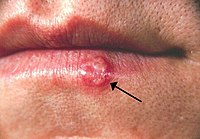
Photo from wikipedia
Recurrent aphthous stomatitis (RAS) are complex inflammatory diseases caused by multi-factors, which severely impact patient quality of life. However, there is still no effective treatment method for RAS without side… Click to show full abstract
Recurrent aphthous stomatitis (RAS) are complex inflammatory diseases caused by multi-factors, which severely impact patient quality of life. However, there is still no effective treatment method for RAS without side effects. Traditionally, Cortex Phellodendri known as “Huang Bai” was used to treat RAS for antibacterial and anti-inflammatory properties in China. Network pharmacology methods and bioinformatics analysis were utilized to search and fish incorporating target. Network analysis and silico validation were used to discover the pharmacological mechanisms of “Huang Bai” for the treatment of RAS. A total of 25 active ingredients in HB, 200 drug targets, and 578 differentially expressed genes (DEGs) between Recurrent aphthous stomatitis and normal samples were obtained. The Gene Ontology enrichment analysis revealed that the immune response was the most significantly enriched term within the DEGs. The KEGG pathway analysis identified 60 significant pathways, most of which involved in the inhibition of inflammation and regulation of immunological response. The functions are dependent on a multi-pathway, particularly the TNF signaling pathway and the HIF-1 signaling pathway. We identified six hub genes in the PPI network, most of which were validated as highly expressed in oral ulcers by DiseaseMeth databases. In addition, molecular docking displayed that the primary molecule combined well with the key targets. “Huang Bai” contains potential anti-RAS active compounds. This study reflects the multi-component multi-target multi-pathway action characteristics of “Huang Bai.” Our study provides potential biomarkers or treatment targets for further research.
Journal Title: International Journal of Immunopathology and Pharmacology
Year Published: 2022
Link to full text (if available)
Share on Social Media: Sign Up to like & get
recommendations!